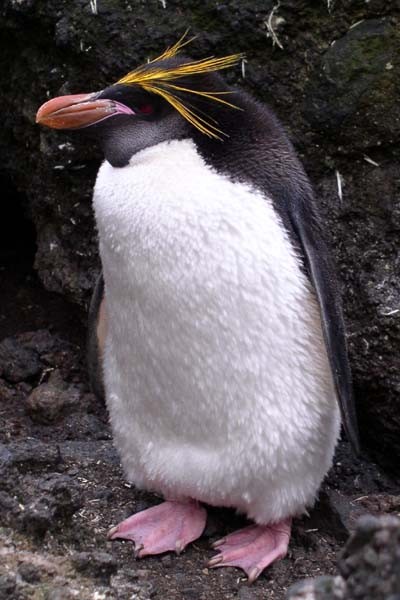Macaroni Penguin
A species of Crested Penguins Scientific name : Eudyptes chrysolophus Genus : Crested Penguins
Macaroni Penguin, A species of Crested Penguins
Botanical name: Eudyptes chrysolophus
Genus: Crested Penguins
Content
Description General Info
 , used under CC-BY-SA-2.5 /Cropped and compressed from original
, used under CC-BY-SA-2.5 /Cropped and compressed from original Description
The macaroni penguin is a large, crested penguin, similar in appearance to other members of the genus Eudyptes. An adult bird has an average length of around 70 cm (28 in); the weight varies markedly depending on time of year and sex. Males average from 3.3 kg (7 lb) after incubating, or 3.7 kg (8 lb) after moult to 6.4 kg (14 lb) before moult, while females average 3.2 kg (7 lb) after to 5.7 kg (13 lb) before moult. Among standard measurements, the thick bill (from the gape) measures 7 to 8 cm (2.8 to 3.1 in), the culmen being around a centimetre less. The wing, from the shoulder to the tip, is around 20.4 cm (8.0 in) and the tail is 9–10 cm (3.5–3.9 in) long. The head, chin, throat, and upper parts are black and sharply demarcated against the white under parts. The black plumage has a bluish sheen when new and brownish when old. The most striking feature is the yellow crest that arises from a patch on the centre of the forehead, and extends horizontally backwards to the nape. The flippers are blue-black on the upper surface with a white trailing edge, and mainly white underneath with a black tip and leading edge. The large, bulbous bill is orange-brown. The iris is red and a patch of pinkish bare skin is found from the base of the bill to the eye. The legs and feet are pink. The male and female are similar in appearance; males tend to be slightly larger. Males also bear relatively larger bills, which average around 6.1 cm (2.4 in) compared to 5.4 cm (2.1 in) in females; this feature has been used to tell the sexes apart. Immature birds are distinguished by their smaller size, smaller, duller-brown bill, dark grey chin and throat, and absent or underdeveloped head plumes, often just a scattering of yellow feathers. The crest is fully developed in birds aged three to four years, a year or two before breeding age. Macaroni penguins moult once a year, a process in which they replace all of their old feathers. They spend around two weeks accumulating fat before moulting because they do not feed during the moult, as they cannot enter the water to forage for food without feathers. The process typically takes three to four weeks, which they spend sitting ashore. Once finished, they go back to sea and return to their colonies to mate in the spring. Overall survival rates are poorly known; the successful return of breeding adults at South Georgia Island varied between 49% and 78% over three years, and around 10% of those that did return did not breed the following year. 
Size
75 cm
Nest Placement
Ground
Feeding Habits
Macaroni Penguin primarily feeds on krill, particularly during breeding, but also consumes squid and fish. Macaroni Penguin forages daily from dawn to dusk, with potential overnight trips as chicks age. Unique behaviors include swallowing stones for diving ballast or digestion aid. They forage near and far from colonies, diving typically to 15-70m depths, occasionally up to 100m, mainly during daylight.
Habitat
Macaroni Penguin primarily inhabit Subantarctic to Antarctic environments, including diverse island systems. Their colonies are often located on rugged terrain, from flat ground to steep slopes laden with scree or amidst lava flows—reflective of their preference for marine and seemingly pelagic settings. Although macaroni Penguin are predominantly coastal, they are known to forage in offshore waters, venturing into temperate regions as distant as islands off the coasts of continents such as Australia, South America, and Africa during feeding expeditions.
Dite type
Piscivorous
General Info
Feeding Habits
Bird food type
Distribution Area
A 1993 review estimated that the macaroni was the most abundant species of penguin, with a minimum of 11,841,600 pairs worldwide. Macaroni penguins range from the Subantarctic to the Antarctic Peninsula; at least 216 breeding colonies at 50 sites have been recorded. In South America, macaroni penguins are found in southern Chile, the Falkland Islands, South Georgia and the South Sandwich Islands, and South Orkney Islands. They also occupy much of Antarctica and the Antarctic Peninsula, including the northern South Shetland Islands, Bouvet Island, the Prince Edward and Marion islands, the Crozet Islands, the Kerguelen Islands, and the Heard and McDonald Islands. While foraging for food, groups will range north to the islands off Australia, New Zealand, southern Brazil, Tristan da Cunha, and South Africa. 
Species Status
The population of macaroni penguins is estimated at around 18 million mature individuals; a substantial decline has been recorded in several locations. This includes a 50% reduction in the South Georgia population between the mid-1970s to mid-1990s, and the disappearance of the species from Isla Recalada in Southern Chile. This decline of the overall population in the last 30 years has resulted in the classification of the species as globally Vulnerable by the IUCN Red List of Threatened Species. Long-term monitoring programs are underway at a number of breeding colonies, and many of the islands that support breeding populations of this penguin are protected reserves. The Heard Islands and McDonald Islands are World Heritage Sites for the macaroni penguin. The macaroni penguin may be being impacted by commercial fishing and marine pollution. A 2008 study suggests the abilities of female penguins to reproduce may be negatively affected by climate- and fishing-induced reductions in krill density. 
Scientific Classification
Phylum
Chordates Class
Birds Order
Penguins Family
Penguins Genus
Crested Penguins Species
Macaroni Penguin